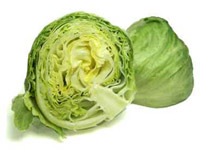Lettuce is a vegetable familiar to the ancient Greeks and Romans. The iceberg variety is a type of lettuce round in shape with a heart and big, tight, crunchy leaves. It’s green on the outside and whiter the closer the leaves are to the centre.
Iceberg lettuce’s high water content compromises the ability to preserve it in ideal eating conditions for long. The best time of year to eat this type of lettuce is in spring but it is now possible to find them all year round.
Iceberg lettuce is a basic component of the Mediterranean diet. Due to its high water content it is low in calories. Most of the vitamins are to be found in the outer leaves and the vitamin content decreases the nearer the leaves are to the centre of the lettuce. This vegetable contains a lot of vitamins, mineral salts and fibre and as a consequence it is one of the nutrient-rich vegetables.
Nutritional information Iceberg lettuce

| Properties of iceberg lettuce | Composition per 100 g: |
|---|---|
| Water (ml) | 16,7 |
| Vitamin C (mg) | 12,2 |
| Potassium (mg) | 240 |
| Magnesium | 5,7(mg) |
| Calcium (mg) | 34,7 |
| Carbohydrate (g) | 1,4 |
| Fibers(g) | 1,5 |
| Proteins | 1,5(g) |
| Vitamin A (mgc de Eq. of retinol) |
29 |
| Folates (mcg) | 33,6 |
| Energy (Kcal) | 16,7 |



